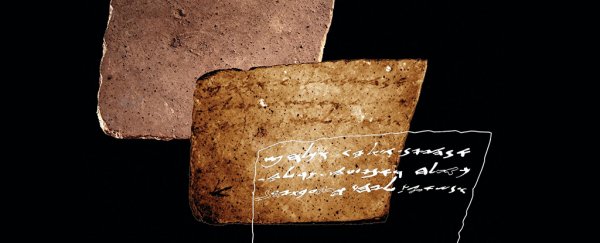Archaeologists have uncovered a secret message on a piece of pottery dating back to biblical times, using the latest in multispectral imaging technology to show scribblings invisible to the naked eye.
The pottery shard, technically known as an ostracon, has been on display in an Israeli museum for more than 50 years but only now has the hidden text come to light. Perhaps unsurprisingly, it starts with a request for wine.
Experts from Tel Aviv University in Israel think the text on the back is a continuation of the inscription on the front, which has always been visible and covers information about various military finances. The piece was originally picked up at Tel Arad, the site of an ancient desert fortress near the modern Israeli city of Arad.
"While its front side has been thoroughly studied, its back was considered blank," says one of the team, Arie Shaus.
After noticing "several marks" on the reverse side of the ostracon, the researchers decided to take a closer look.
"To our surprise, three new lines of text were revealed," says Shaus.
The multispectral imaging technique used by the researchers can show light on wavelengths invisible to the human eye, like the infrared beams sent from your remote control to your television.
Images of the pottery were snapped using a modified Canon SLR 450D digital camera and a series of filters covering different parts of the light spectrum, then processed in an editing application to bring out the text.
In total, 50 new characters and 17 new words were revealed using the process. The message begins with a request for wine, before guaranteeing assistance if the recipients of the message have any requests of their own.
Finally there's a request for the provision of a certain unnamed commodity to a certain unnamed person, and a note about a particular measurement of wine carried by someone called Ge'alyahu.
About 20-30 soldiers would have been stationed at the outpost around the time of 600 BCE, when the pottery dates from. It would seem getting a steady supply of alcohol was pretty high up on their list of priorities.
Now the scientists behind the reveal are keen for the same multispectral imaging approach to be used on other ancient pieces of pottery – otherwise who knows what kind of messages and inscriptions we could be missing?
The team is also planning to test their new technique on other artefacts themselves, to see if any more revealing messages are hiding in plain sight. Those messages could teach us much more about how ancient civilisations lived.
"Each new line, word, and even a single sign is a precious addition to what we know about the First Temple period," says one of the team, Anat Mendel-Geberovich.
The research has been published in PLOS One.
